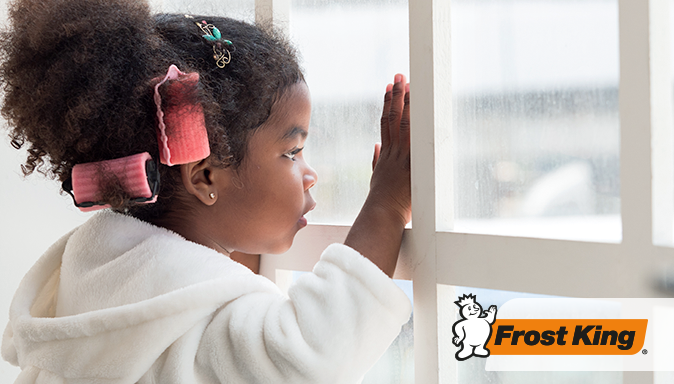Buttoning up your home for winter can save big bucks on your winter heating bills—we’re talking 15% of your annual heating and cooling costs—and help get your home ready to weather whatever storms come your way.
We’ve rounded up 14 winterizing projects that can pay off big time. The best part? Some of them can get crossed off your to-do list in an afternoon.
1. Add Window Film: Want a way to reduce drafts from old windows, help your house feel warmer and reduce condensation on the glass? Yes please! Frost King’s Window Insulation Shrink Kits do all of the above—and they’re crystal clear so you still get a great view of the outdoors. Not sure if you need them? Energy Star says to look out for rattling windows, visible gaps around the window or door trim, noticeable pests and dust entering through gaps or holes in or around windows, odors from outside, or peeling paint around the window frame as a sign that you need to add window film. Installation is a cinch. Watch this video for step-by-step instructions:
2. Add Some Window Treatments: Thick, insulated curtains or drapes don’t just make your house look homier. They can actually act as an extra barrier against drafts so your rooms feel warmer. Keep them closed at night and open them in the morning to let the sun’s rays warm your home.
3. Seal Gaps and Cracks: Check around windows and doors. See any gaps or cracks that are letting cold air in and warm air out? If so, grab some caulk and weatherstripping and get to work plugging the leaks. Watch this video to learn how to choose the right weatherstripping for your project:
4. Close the Door on Drafts. If you’ve added weatherstripping to door frames and still feel a draft coming in, add a draft stop to the bottom of your door. It easily slips onto the bottom of the door to block drafts from the inside and outside at the same time.
5. Get Smart About Heating Your Home: Are you paying big bucks to heat your house when no one’s even home? A smart thermostat lets you easily set your heating system to lower temperatures when you're away or at night and higher temps when you're at home during the day—and it can even automatically adjust to your schedule so your home always feels comfortable. According to Energy Star, this simple switch could save you 8% on your heating and cooling bills annually.
6. Maintain Your Furnace: Want to keep your furnace running smoothly? Schedule a professional inspection and maintenance at the beginning of the season to make sure all the components are in good working order and it's running efficiently. Change the air filter regularly to maintain good air quality in your home; typically, a fiberglass air filter needs to be replaced every 30 days while a pleated air filter should be replaced every three to six months.
7. Draft-Proof Electrical Outlets: Electrical outlets and light switches on exterior walls are a sneaky source of heat loss. Install Electric Outlet Sealers to seal gaps behind the plate covers. This video shows you how:
8. Add Insulation: Many older homes are poorly insulated—especially in unheated areas like basements, attics, and garages. If your home lacks proper insulation, you may want to add more to reduce heat loss and make your house feel more cozy.
9. Seal Ducts: Leaky ductwork can mean that 20% of the air you’ve paid to heat never makes it to your rooms. You may be able to feel large leaks just by holding your hand up to the ducts, or you can find less obvious leaks by holding a tissue up to the duct joints; if the tissue begins to move, you’ve got a leak that’s wasting energy and needs to be wrapped with duct wrap to improve your heating system’s efficiency.
10. Insulated Pipe Wrap: Insulating hot water pipes reduces heat loss and can raise water temperature 2°F–4°F hotter than uninsulated pipes, so you can lower the water temperature setting on your hot water heater and still get a nice hot shower. Frost King’s Tubular Foam Pipe Insulation makes this job easy: the tubes are pre-slit so they slip over pipes quickly:
11. Reverse Ceiling Fans: If you’re only using your ceiling fans in the summer, you’re missing out on an easy (and inexpensive) way to make your home feel warmer. A ceiling fan can push warm air that rises back down …but you have to set it to rotate clockwise to send the warm air that collects near the ceiling into your room. On most fans, blade direction is controlled by a small switch on the fan’s motor.
12. Check Your Roof: Regular roof maintenance can mean the difference between expensive leaks and water damage and a secure home. Do a visual inspection to make sure your roof is in good condition and replace any missing or damaged shingles. You may also want to add a Roof and Gutter De-Icing Kit to protect your roof from ice dams that can damage shingles.
13. Clean Gutters: Your home’s gutters capture rainfall and snowmelt from your roof and whisks it away from your home and foundation—but if they’re clogged, they can’t do their job. Before winter hits, make it a point to clean out gutters, then install gutter guards or screens to keep them clear of debris. If you notice water pooling at the base of downspouts, our new Tilt and Drain Downspout can help you keep water flowing away from your home and into your yard.
14. Get Your Chimney Cleaned: If you have a fireplace, schedule a chimney cleaning to remove creosote buildup and ensure it's safe to use. And get your firewood ordered and stacked now, before cold days are here.
